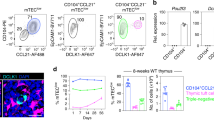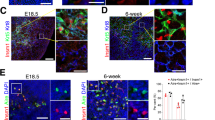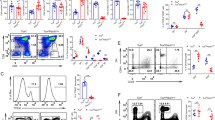Abstract
The mechanism underlying the autoimmune polyglandular syndrome type-1 (APS1) has been attributed to defective T-cell negative selection resulting from reduced expression and presentation of autoantigens in thymic medullary epithelial cells (MECs). It has also been postulated that Aire is involved in development of regulatory T cells, although supporting evidence is lacking. Here we show that expression of Aire in MECs is required for development of iNKT cells, suggesting a role for iNKT cells in APS1. NOTE: We are retracting this report as it contains several errors, including duplications and manipulations of some flow cytometry plots in Figure 1a and in Supplementary Figure 2 online, incorrect juxtaposition of data in Figure 1g (spleen) that in fact derive from different experiments, and inaccurate reporting of the absolute number of iNKT cells and s.d. values, even though the statistical significance remains unchanged. Although original data exist for each figure that largely support the conclusions drawn, we believe that the number of figures affected means that the appropriate response is to retract this paper.
This is a preview of subscription content, access via your institution
Access options
Subscribe to this journal
Receive 12 print issues and online access
$209.00 per year
only $17.42 per issue
Buy this article
- Purchase on Springer Link
- Instant access to full article PDF
Prices may be subject to local taxes which are calculated during checkout


Similar content being viewed by others
References
Ruan, Q.G. & She, J.X. Clin. Lab. Med. 24, 305–317 (2004).
Anderson, M.S. et al. Science 298, 1395–1401 (2002).
Kuroda, N. et al. J. Immunol. 174, 1862–1870 (2005).
Ramsey, C. et al. Hum. Mol. Genet. 11, 397–409 (2002).
Liston, A. et al. Nat. Immunol. 4, 350–354 (2003).
Anderson, M.S. et al. Immunity 23, 227–239 (2005).
Mathis, D. & Benoist, C. Immunity 20, 509–516 (2004).
Matsuda, J.L. & Gapin, L. Curr. Opin. Immunol. 17, 122–130 (2005).
Mi, Q.S. et al. Diabetes 53, 1303–1310 (2004).
Sivakumar, V. et al. J. Exp. Med. 197, 1613–1621 (2003).
Wagner, M.J. et al. J. Immunol. 174, 6764–6771 (2005).
Heino, M. et al. Eur. J. Immunol. 30, 1884–1893 (2000).
Zhou, D. et al. Science 306, 1786–1789 (2004).
Wei, D.G. et al. J. Exp. Med. 202, 239–248 (2005).
Chin, R.K. et al. Nat. Immunol. 4, 1121–1127 (2003).
Acknowledgements
We thank R. Brutkiewicz and K. Hayakawa for the gifts of NKT cell lines, L. Peltonen for providing the initial Aire−/− mice and Kirin Brewery Pharmaceutical Co. for α-GalCer. We acknowledge H. He for his assistance with artwork. This work was supported in part by grants from the American Diabetes Association (to Q.-S.M.), the Juvenile Diabetes Research Foundation International (to Q.-S.M.), the US National Institutes of Health (to J.-X.S.) and the Canadian Institutes of Health Research (to T.L.D.).
Author information
Authors and Affiliations
Corresponding authors
Ethics declarations
Competing interests
The authors declare no competing financial interests.
Supplementary information
Supplementary Fig. 1
The number of iNKT cells is reduced in NOD. Aire-deficient mice. (PDF 134 kb)
Supplementary Fig. 2
Percentages of CD4, CD8, iNKT and NK cells in Aire-deficient mice. (PDF 1100 kb)
Supplementary Fig. 3
Autoantibodies in bone marrow recipient mice. (PDF 627 kb)
Supplementary Fig. 4
Gene expression analyzed by quantitative RT-PCR. (PDF 539 kb)
Rights and permissions
About this article
Cite this article
Mi, QS., Deng, ZB., Joshi, S. et al. The autoimmune regulator (Aire) controls iNKT cell development and maturation. Nat Med 12, 624–626 (2006). https://doi.org/10.1038/nm1424
Received:
Accepted:
Published:
Issue Date:
DOI: https://doi.org/10.1038/nm1424
This article is cited by
-
Experimental models of spontaneous autoimmune disease in the central nervous system
Journal of Molecular Medicine (2007)
-
Retraction Note to: The autoimmune regulator (Aire) controls iNKT cell development and maturation
Nature Medicine (2006)
-
In the absence of AIRE...
Nature Reviews Immunology (2006)



